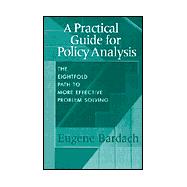| Preface | xi | ||||
| Introduction | xiii | ||||
| Policy Analysis: More Art than Science | xiv | ||||
| The Eightfold Path | xiv | ||||
| Iteration Is Continual | xiv | ||||
| Some of the Guidelines Are Practical, but Most Are Conceptual | xv | ||||
| The Concepts Come Embedded in Concrete Particulars | xv | ||||
| Your Final Product | xv | ||||
| The Spirit of the Eightfold Path | xvi | ||||
| Part I. The Eightfold Path | 1 | (46) | |||
|
1 | (6) | |||
|
2 | (1) | |||
|
2 | (2) | |||
|
4 | (1) | |||
|
4 | (1) | |||
|
5 | (1) | |||
|
5 | (2) | |||
|
|||||
|
|||||
|
7 | (1) | |||
|
7 | (5) | |||
|
9 | (1) | |||
|
|||||
|
|||||
|
10 | (1) | |||
|
10 | (1) | |||
|
11 | (1) | |||
|
11 | (1) | |||
|
11 | (1) | |||
|
12 | (1) | |||
|
12 | (7) | |||
|
12 | (2) | |||
|
14 | (2) | |||
|
16 | (1) | |||
|
17 | (2) | |||
|
19 | (1) | |||
|
19 | (8) | |||
|
19 | (1) | |||
|
20 | (1) | |||
|
20 | (3) | |||
|
|||||
|
|||||
|
|||||
|
23 | (1) | |||
|
|||||
|
|||||
|
24 | (2) | |||
|
|||||
|
|||||
|
|||||
|
26 | (1) | |||
|
|||||
|
|||||
|
27 | (10) | |||
|
28 | (1) | |||
|
29 | (1) | |||
|
29 | (3) | |||
|
32 | (3) | |||
|
|||||
|
|||||
|
|||||
|
|||||
|
35 | (1) | |||
|
36 | (1) | |||
|
37 | (3) | |||
|
38 | (1) | |||
|
|||||
|
39 | (1) | |||
|
39 | (1) | |||
|
40 | (1) | |||
|
41 | (1) | |||
|
41 | (6) | |||
|
41 | (1) | |||
|
42 | (1) | |||
|
42 | (1) | |||
|
43 | (1) | |||
|
44 | (1) | |||
|
|||||
|
|||||
|
|||||
|
|||||
|
|||||
|
45 | (1) | |||
|
|||||
|
|||||
|
46 | (1) | |||
|
46 | (1) | |||
| Part II. Gathering Data for Policy Research | 47 | (24) | |||
|
48 | (2) | |||
|
50 | (1) | |||
|
50 | (3) | |||
|
|||||
|
|||||
|
|||||
|
|||||
|
53 | (1) | |||
|
54 | (1) | |||
|
55 | (1) | |||
|
55 | (1) | |||
|
56 | (2) | |||
|
58 | (1) | |||
|
58 | (2) | |||
|
59 | (1) | |||
|
60 | (3) | |||
|
63 | (4) | |||
|
67 | (1) | |||
|
67 | (1) | |||
|
68 | (3) | |||
|
69 | (2) | |||
| Part III. ``Smart (Best) Practices'' Research: Understanding and Making Use of What Look like Good Ideas from Somewhere Else | 71 | (16) | |||
|
71 | (1) | |||
|
72 | (5) | |||
|
72 | (4) | |||
|
76 | (1) | |||
|
77 | (10) | |||
|
77 | (2) | |||
|
|||||
|
|||||
|
|||||
|
79 | (2) | |||
|
|||||
|
|||||
|
|||||
|
81 | (1) | |||
|
82 | (2) | |||
|
|||||
|
|||||
|
84 | (3) | |||
| Appendix A. Things Governments Do | 87 | (10) | |||
|
87 | (1) | |||
|
87 | (1) | |||
|
87 | (1) | |||
|
88 | (1) | |||
|
88 | (1) | |||
|
88 | (1) | |||
|
89 | (1) | |||
|
89 | (1) | |||
|
89 | (1) | |||
|
|||||
|
|||||
|
|||||
|
90 | (1) | |||
|
90 | (1) | |||
|
90 | (1) | |||
|
90 | (1) | |||
|
90 | (1) | |||
|
91 | (1) | |||
|
91 | (1) | |||
|
91 | (1) | |||
|
91 | (1) | |||
|
91 | (1) | |||
|
91 | (1) | |||
|
92 | (1) | |||
|
92 | (1) | |||
|
92 | (1) | |||
|
93 | (1) | |||
|
|||||
|
|||||
|
93 | (1) | |||
|
93 | (1) | |||
|
93 | (1) | |||
|
94 | (1) | |||
|
94 | (1) | |||
|
94 | (1) | |||
|
94 | (3) | |||
|
94 | (1) | |||
|
94 | (3) | |||
| Appendix B. Semantic Tips: A Summary | 97 | (1) | |||
|
97 | (1) | |||
|
98 | (1) | |||
|
98 | (1) | |||
|
99 | (1) | |||
|
100 | (1) | |||
|
101 | (1) | |||
|
101 |








